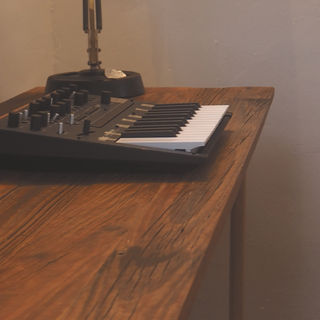cape town, south africa

Pocket studio
Modular re-used acoustic fittings for a small music studio.
The vision was to convert a small cottage, nestled in fynbos at the bottom of a garden on the stormy coastline of the Cape Overberg, into a small music studio. Finding and consolidating a stock pile of used wood left out in the rain behind the cottage, inspired me to build the whole project exclusively out of it, the appeal being to make something functional and aesthetically pleasing out of "junk".
The main room was a mere 2.4 x 2.4 meters, so space was going to be a major constraint, especially because a full drum kit was going into it. The dimensions were almost cubic, which after doing some research, presented its own unique sonic issues. The materials available were not endless, and careful planning was necessary to build around the various cuts that were at my disposal. Time was not an issue as it was lockdown 2019.

Some acoustic problems were predicted by research and some identified by ear. Spending a good amount of time playing sounds in various positions of the bare room allowed me to get an idea of its "sound" and which aspects of it I wanted to keep and which needed to go. Its cubic nature meant that at least one of the walls needed to be off-set to prevent a build-up of problem frequencies in the centre. The low, but slightly sloped ceiling was a boon for the vertical direction.
After about a week of cutting and sanding to clean up the wood, the excitement was building as I realised that I had some beautiful and characterful pieces to work with - mostly Oregon Pine, Meranti and Oak.

Because of the cube-problem and the limited space, materials were prioritised around a multi-functional unit which both treated sound, while at the same time provided customised storage space for studio gear. The unit's alternating angled panels would off-set the walls while further acting as sound absorbers and dispersers: Doors of the cupboard-sections were slatted to disperse/scatter, and white canvas-upholstered acoustic panels with "rock-wool" would absorb. All the acoustic panels would slide snugly in, and pop out with little fish-line hooks, so that wall-mountings could be accessed, and to allow for future modifications. The bottom door slides over the adjacent acoustic panel to conserve the work area while the top ones swing over-head. The unit was raised an ergonomic height off the floor to conserve floor space. The long slopes were designed at the same angle as the ceiling's for subtle continuity.

With the left-over wood a work-desk and four additional acoustic panels were carefully designed and positioned to give the room a balanced look and sound. The room also has an en-suite wash-room with a sliding door, which was further enhanced by converting the studio-facing side into an acoustic panel.
The end-product is a completely unique studio where form follows function. It is not completely ‘dead’, but still has a certain character, which holds even when playing at high volumes. The en-suite bathroom doubles up as an interesting audio effect when you open the door and place a mic in it to record an instrument in the room, acting as a type of reverb chamber that you can combine with a dryer signal from within the room. The look is really pleasing and tranquil, and has this 70’s vibe with the angles and slats. Quiet functionality and warm simplicity.





